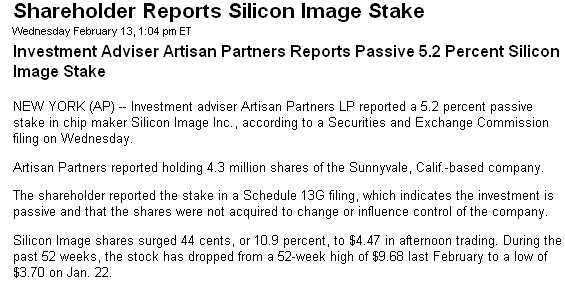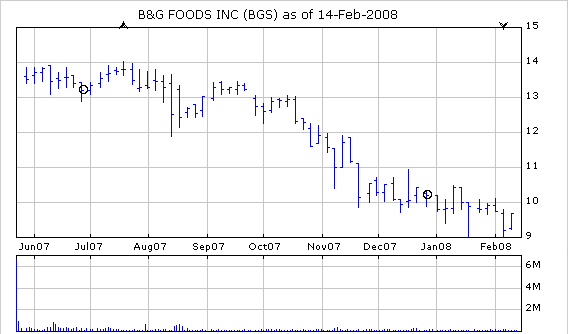Chip Makers
After making some nice change on RNIN, I
decided to sell about 50% and do some diversifying.
Lots of stocks out there at or near their 52 week lows.
The first place I decided to revisit was the chip sector.
I was looking for a small cap company trading at its lows, had a
positive PE and if at all possible, was cash rich.
I also wanted a company with some reasonable prospects for the future -
something you could put some money into and let it ride.
There were several such animals and I settled on one - Silicon Image Inc. (SIMG)

The company has lots of cash and it is debt free. Sales have
stalled, but that is no big surprise considering the climate.
Read up on everything the company is involved with. It is
impressive.

Apparently Artisan likes the company too.
Motley Fool has an article out about the company where in closing they
state if just a few things go right for this company,
then it is dirt cheap to get into at these prices.
Grocery Shopping
I sold the rest of my Owens Corning
(OC) a while ago and was looking for something that paid a nice healthy
dividend and had a fairly stable share price and wound up with B&G Foods (BGS).

This company went public a couple years ago and for a small cap
company,has been doing quite well.
I am not so concerned with a dramatic increase in share price (although
that would be quite nice) as I would like to see a return which beats
money market funds while the economy is in flux.
The company has been paying out quarterly dividends of @ 21 cents and
relative to the share price, this is quite healthy.

It figures out to somewhere in the neighborhood of 8-9%.
That certainly beats a money market.
This
is a small amount relatively speaking so I think this stock fills
the bill.
Food and Transportation costs are pretty easy to pass on to
the consumer.
Everyone has to eat and most people have to drive.
They also have another hybrid stock (BGF)
which is called an EIS, or Enhanced Income Security which also includes
callable bonds as part of its makeup. There have been some
favorable write-ups on this EIS. It seems to be classified as
an
equivalent to a high yield corporate bond. Might be worth
looking
into as well:
The
Long Case for B&G Foods - A Stock/Bond Hybrid
posted on: October 12,
2006
| about stocks: BGF
Imagine
a security designed exclusively for the long-term income investor. On
top of a close to double-digit yield, it would come from a safe
industry -- say, foods -- that's pretty much immune to interest rate
changes. You could count on its income stream, which is as reliable as,
say, a CD. And yet, this ideal security would have the upside growth
potential of a stock.
The
security I have in mind is also on the fast track, as it is poised to
deliver double-digit earnings growth over the next two years. I'm
talking about snack food maker B&G Foods (BGF). This maker of
pickles, seasoning, and salsa could add some spice to your portfolio.
No
ordinary stock, BGF is a stock/bond hybrid wrapped in one. It's one of
a handful of Income Deposit Securities designed to appeal to income
investors, and its 9.5% yield is just one of its many attractive
features. To get the full plate of goods on this security, please read
on.
Snapshot
The
maker of B&G pickles, Ortega tacos and sauces, and Grandma's
Molasses, B&G Foods sells condiments and spices to grocery
chains
and food service outlets. Wal-Mart is its biggest customer and
celebrity chef Emeril Lagasse's line of seasonings is its top-selling
brand. The snack food maker has manufacturing plants across the U.S.
from Maine to Wisconsin, and sells its products throughout North
America.
Formed
in 1996, BGF went public in October 2004. It was the second Income
Deposit Security to hit the market, after only food caterer Centerplate
(CVP). Laundry equipment provider Coinmach (DRY) and rural telecom
Otelco (OTT) have since joined the list.
Dividend
BGF
has delivered dividends of 42.7 cents per security every quarter for
the past year. That gives the shares an annual payout of $1.71 and a
current yield of 9.0%.
As
an Income Deposit Security [IDS], each security comprises one share of
common stock, plus a bond with a 10-year term. In 2005, the cash
payment comprised 81 cents in common share dividends and 90 cents in
interest income from the bond.
Keep
in mind that the dividend portion may rise and fall with the company's
cash flow. Last year, most of BGF's dividend was treated as a return of
capital, which is generally taxed at the 15% capital gains rate when
you sell the shares.
The
interest income part of the security's distribution is fixed at 12% of
a bond. It's taxed as ordinary income, making the shares suitable for
tax-advantaged accounts. As of right now, the company has no dividend
reinvestment plan in place.
Growth
Drivers
After
a series of acquisitions, B&G has grown since its start in 1996
from about $100 million in sales to roughly $400 million today. It has
made eight acquisitions in as many years, including the $30 million
purchase this February of the Grandma's Molasses brand from Cadbury
Schweppes.
Brand
recognition is the name of the game in the food industry, and the
company has leveraged the success of its top brands by developing a
bevy of products under such popular labels as Emeril, Ortega, and
Polaner. Since acquiring the Polaner line of preserves in 1999,
B&G
has transformed it into North America's leading brand of low calorie
fruit preserves. It has captured nearly a 50% share of the sugar-free
preserve market by targeting the rapidly growing diabetic population
and appealing to widespread concerns about obesity and nutrition.
Like
other food makers, B&G is facing rising food and packaging
costs.
In an effort to improve profit margins, the company has started
shuttering low-margin production facilities. In July 2005, for
instance, it closed its large Trappey's hot sauce plant in Louisiana.
To
keep profit margins strong, B&G is also trying to implement
price
increases on its products. Its retail clients are facing competitive
pressures of their own, so the price increases are a tough sell,
according to CEO David Wenner. Despite these headwinds, the company was
able to boost its per-share earnings by +32% -- and that's on just a
+9% increase in sales -- over the last three years.
Outlook
B&G
has put together an extremely attractive portfolio of popular food
brands that have been around for years and are well recognized by
consumers. Acquiring new labels will continue to be an important part
of management's growth strategy. However, even more important to the
company's long-term success is its ability to adapt its products and
packaging to ever-evolving consumer tastes.
Cost
pressures are a headwind, but the steps the company is taking to raise
prices and cut costs should continue to boost the bottom line. Over the
next two years, per share earnings are forecast to climb about +17% to
an estimated 62 cents per share in 2007.
With
some 55% of the shares in the hands of large institutional
shareholders, BGF's share price doesn't typically make huge moves up or
down. Trading at a P/E of about 30 times this year's projected
earnings, the shares are selling at somewhat of a premium to the
overall market. Still, when you consider BGF's monster dividend yield,
the shares deserve to trade at a premium.
As
more investors learn about income deposit securities, I expect this
security to increase its price by leaps and bounds.
Disclosure:
Author has no position in BGF |
Lets see: Food,
Games, Chips, GE, Finance, Digital Signage.
Do you suppose I
could play, "Am I Diversified?"
|







